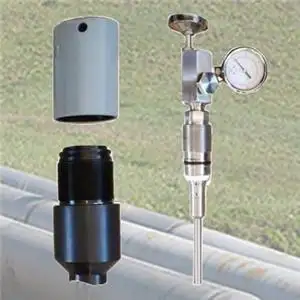Description

Resistance technology is the most widely used method to measure the amount of metal loss inside the equipment and pipe. Its technical characteristics are to measure the change of the resistance value of the external measured metal element immersed in a certain medium relative to the reference resistance value sealed inside the probe. The change in temperature also affects the metal loss of the metal element measured by the probe.
If the state change of the corroded pipe is uniform, then the change of resistance value of the resistance probe increases with the depth of corrosion of the pipe in a certain proportion. Rather than being used more frequently than other corrosion monitoring methods, resistance probes are uniquely adapted to water vapor, gases, soil, wet carbohydrates, and non-electrolytes of insoluble liquids in harsh or intermittent electrolytes.
Design principle of resistance probe for corrosion monitoring
Corrosion monitoring probes measure the loss of corroded or eroded metals by electrical resistance. This method is used in virtually any environment except for liquid metals and some conductive molten salts. Corrosion monitoring probes based on resistance measurement can directly measure the amount of metal loss. Metal loss and corrosion rate can be plotted as a function of time, and the slope of the curve is the average corrosion rate of metal corrosion in the selected time interval.
The resistance of a conducting substance is expressed by the formula: R=P(T)L/S, P(T): The inherent resistivity of a substance as a function of temperature, L: Length of the section, S: The area of the section, The inherent resistivity of a substance varies with the alloy and is closely related to temperature. For an alloying material at a given constant temperature, the resistance increases as its cross-section decreases, without changing its length. Therefore, the resistance measurement is used to determine the loss of metal and compensation for the change in resistivity due to temperature obtained by using standard (reference resistance built into the probe, protected from corrosion in the environment) components. When the resistance R of the exposed element under test increases with the temperature, the resistance value of the reference resistance (R,) inside the probe will also increase accordingly. Therefore, theoretically, the resistance ratio R/R should not change with the change in temperature, thus realizing the automatic compensation of the temperature effect.
Because the corrosion monitoring probe has a lower resistance than the cable and connector, separate current and voltage measurement lines must be used to activate the probe element through the same current. The ratio of voltage between the resistance element under test and the reference resistance element can be measured.

Different corrosion monitoring probes have different applications. The main probes are classified as follows:
1. Internal monitoring probe (a can be moved under system pressure, b cannot be disassembled under system pressure)
2. Laboratory probe
3. External and structural monitoring probes
4. Environmental probe
According to the mounting method of the probe, it can be divided into a retractable search (pressure mounting) and a fixed probe. Retractable probes are operated through an instrument box with an external valve mounted. This special retractable device makes it easier to insert or move the examination at 1,500 psi of the system pressure, which is too high to permit manual operation (over 150 psi). Stationary probes operate at a system pressure of 3,600Ps to 6,000Psi (probes are not movable, due to economic or specific constraints, they are usually mounted on flanges or NPT connections. (1Psi: 1 pound per square inch, absolute pressure).
The need for corrosion monitoring:
The corrosion rate determines the effective and safe operation time of the equipment. Corrosion measurement and inhibition of high corrosion rate behavior minimize operating costs and reduce operating cycle costs.
Corrosion monitoring can work in a number of ways:
By providing early warning to remind of the possible existence of faults caused by corrosion.
Study the relationship between the change of process parameters and its corrosive effect on the system.
Diagnose specific corrosion problems and identify the causes and parameters that enable corrosion rate control such as pressure, temperature, pH, flow rate, etc.
Evaluate corrosion control and prevention techniques, such as chemical suppression, and determine the most effective corrosion control and prevention techniques.
Provide management information related to plant condition and maintenance needs.

Resistance (ER) monitoring
The resistance probe can be considered an electronic mount. Like a hanger, an ER probe provides a baseline for measuring the weight loss of a metal, but unlike a hanger, the weight loss of a metal can be measured at any time and with any desired frequency, as long as the probe is in the same position and permanently exposed to the stream.
ER probes measure changes in the electrical resistance of corroded metals exposed to industrial liquid flows. Corrosion on the surface of the measuring element reduces the cross-sectional area of the metal and increases the resistance accordingly. The increase in resistance is directly related to the metal loss, which in turn is a function of time, allowing the rate of corrosion to be calculated. Although a time-averaging method, the ER probe response time is much less than that of the weightless hanging piece.
In addition to all of the advantages of the hanging piece, the ER probe can directly obtain the corrosion rate. The probe is installed in the field until exhausted, responds quickly to new corrosion, and can be set to alarm.
resistance probe





Reviews
There are no reviews yet.